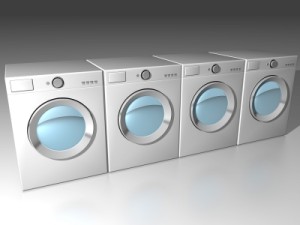Moving out of home is exciting, mind-numbing and expensive; not only do you suddenly have to wash your own clothes, you need to buy a machine to process the cleaning system, in all of it watery, detergent glory. Top loading, front loading, who knows the difference beyond where the door is located and how fast the clothes disappear into the chrome tubs, vented with water. Gratefully, the differences are pretty simple and easily laid out below – there’s no wrong choice, as yes, all washing machines perform the same job. Some are more efficient, some consume less power, some waste less water, some have control panels and computers, and some cost the price of your car. It’s really up to you.
The Top Loader
The top loader is a classic machine; the chrome tub is placed vertically inside the casing, staggered over an agitator. It sounds aggressive, doesn’t it? Well, it is. The agitator pushes water and clothes around, forcing the soapy water to clean your clothes, before draining and refilling, to rinse and repeat as the cycle progresses.
The Benefits:
Pre-Existing Injury: If you’re riddled with knee pain or back issues, a top loader will reduce the strain on these injuries and joints, as heavy load demand attention. Front loaders require you to bend over and duck clothes into a limited space, punishing any existing irritations and exacerbating their causes.
Price: The front loaded is heavy on the pocket, costing more than most of us can afford when we’re first starting out. The top loader continues to be the more affordable option.
Emergency Stop: Have you ever forgot to add a stray sock to the mix or found a favourite shirt you just had to wear the next day? A top loader will allow you to abort the wash momentarily, without locking you in for the whole cycle like a front loading washing machine.
The Front Loader
The front loading machine is highly economical choice, although the initial outlay may be a killer to some. Working on similar dynamics to a top loader, front loading models lack an agitator, relying on gravity to distribute water, detergent and softener evenly. Not only does this improve the longevity of your clothing, the front loaded is highly environmentally friendly, as you’ll soon see.
The Benefits:
Space Saving: Front loading machines are handy, as they make great building blocks; most are fully stackable, as dryers can be piled on top or below these ingenious machines, allowing you to make the most of our your laundry or bathroom, depending on the where your appliances are located.
Efficient: Environmentally friendly, a front loader only require about a third of the water found in a top loading machine and without the presence of the terrifying agitator, larger loads are possible. An added benefit is the spin cycle speed, some models clocking in at 1000 rpm to ensure less water seeps into the clothes leading to shorter times in the dryer or in the sun.
Like we said before, there’s no right answer here, nobody will judge you for the LG washing machine you pick up second hand, or the Sony homemaker you picked up for half price, they all do the same job.

Thanks for sharing about these free printables.
I have been a musician for years, and this is the best article I have ever read on learning to…
Great info! Whenever I have a clogged sink or drain, I call my local pluber for drain cleaning services in…
No matter what treatment you use, your gums are more likely to be sensitive to the chemicals used to whiten…
Hi Olga nice to meet you. Like you I’ also longing for my daughter who is already an angel in…